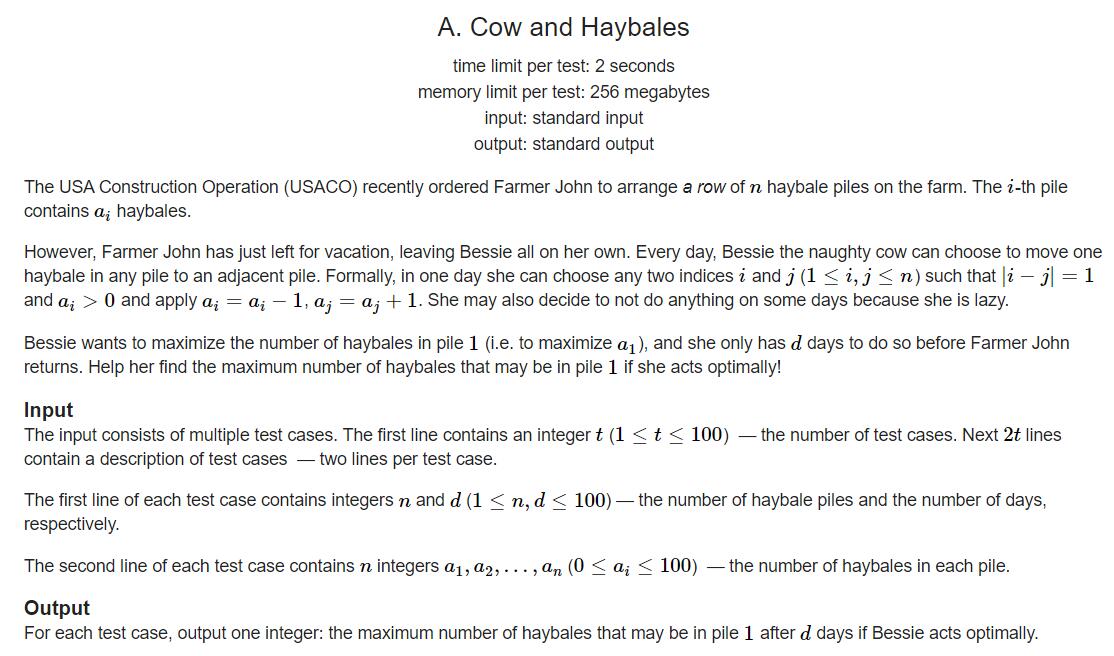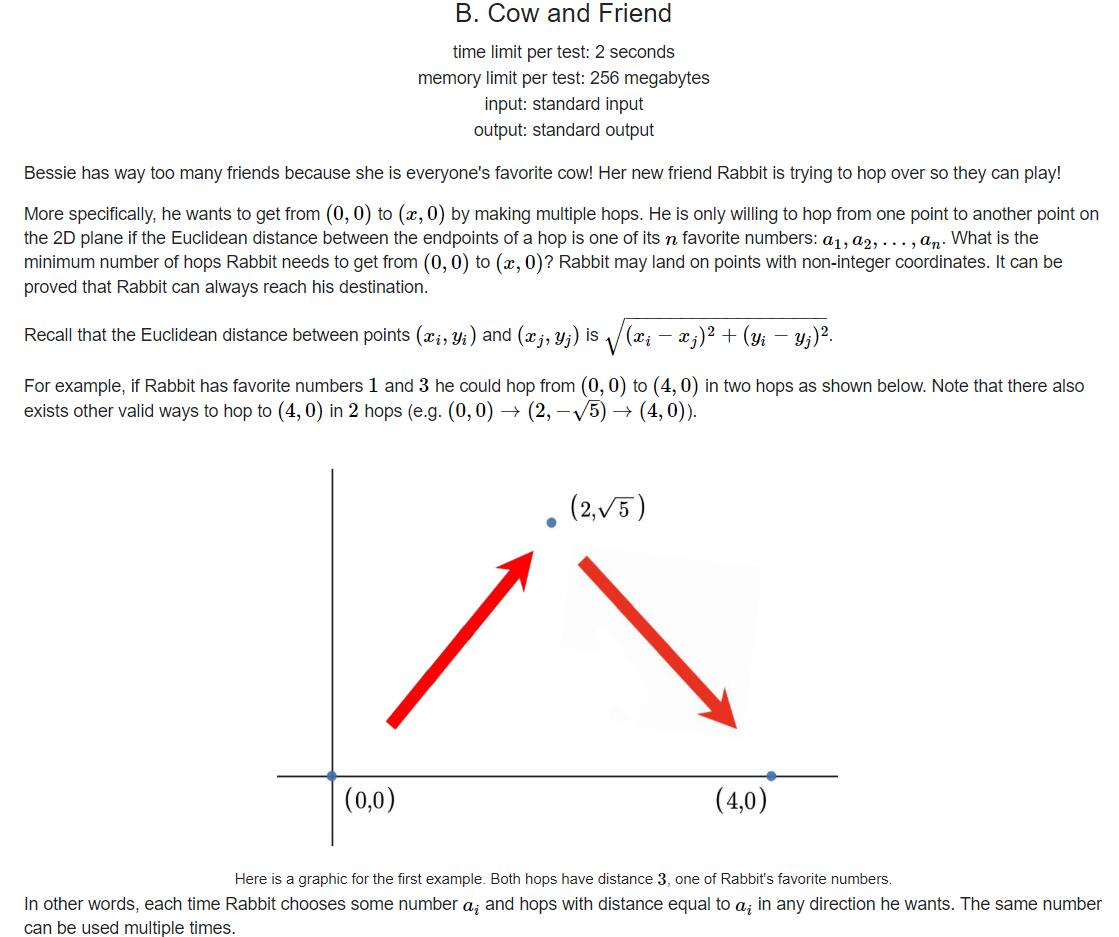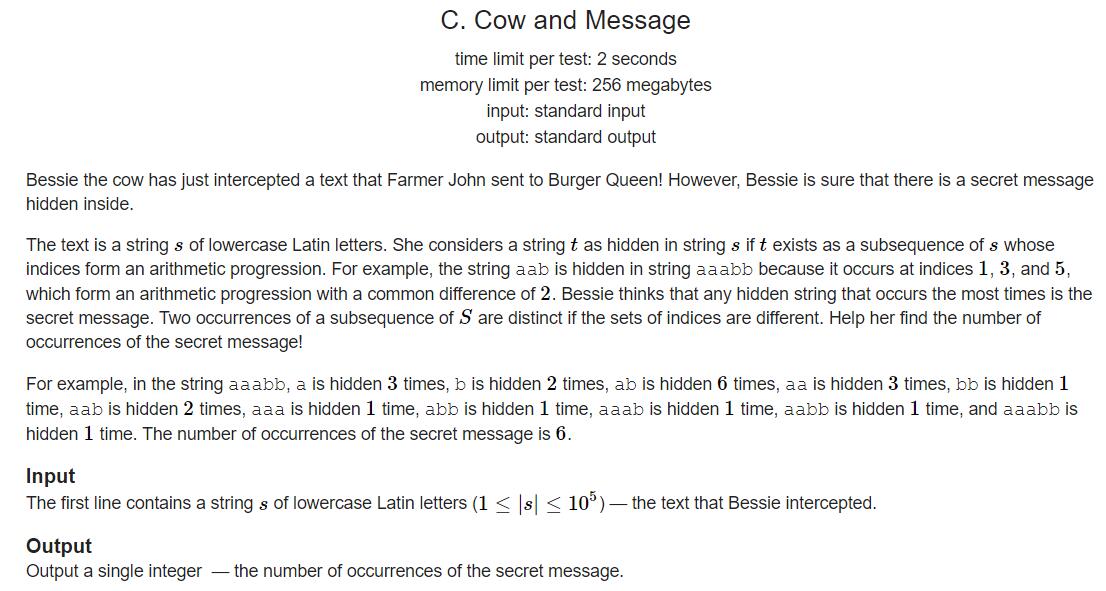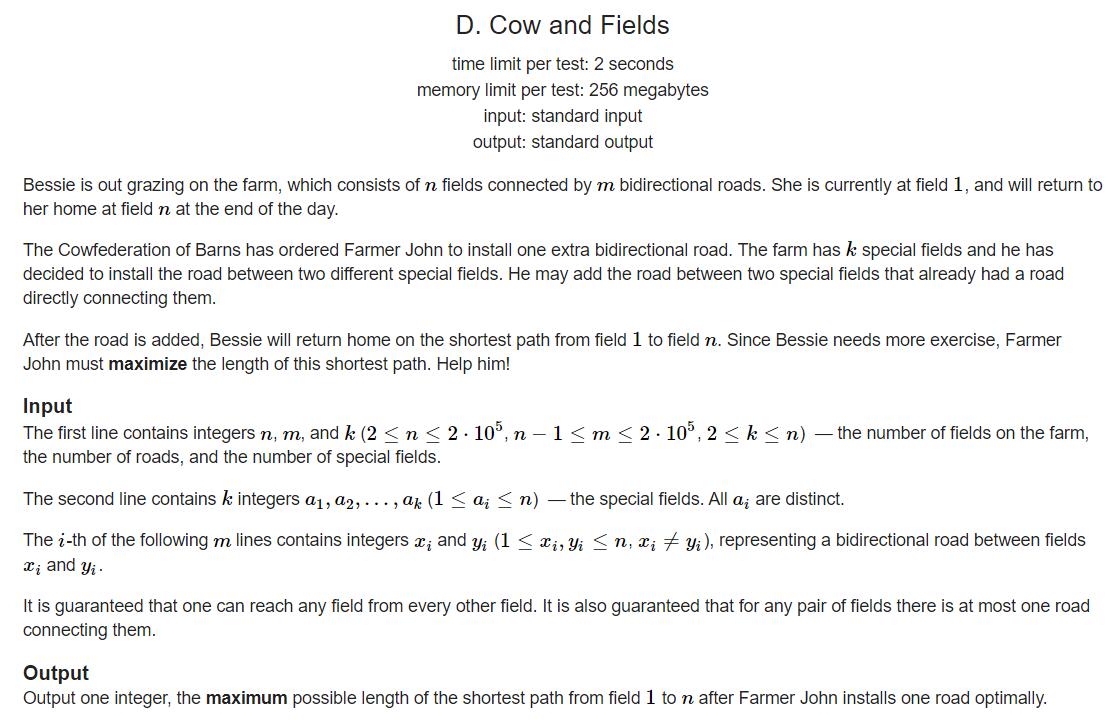居然这场比赛是11点35开始,打完都2点了,开学第一天就这样,根本hold不住。
总体来说,这次稀奇古怪的想法比较多,所以作为新手刚入门,也过了3道,rating上了1500,比初始值高了……
另外这场比赛的USACO风格倍感亲切。
A. Cow and Haybales
题目链接
题目原文

题目大意
给从左到右 n 个堆 ,每个堆有 ai 个东西,每天可以把第 i 个堆里的 1 个东西拿到第 i−1 个堆里。现问 d 天后第一个堆里最多有多少个东西。
思路
直接模拟,第 i 个堆里的一个东西搬到第一个堆里需要花费 i−1天。
代码
1
2
3
4
5
6
7
8
9
10
11
12
13
14
15
16
17
18
19
20
21
22
23
24
25
26
27
| #include < cstdio >
#include < cstring >
#include < algorithm >
using namespace std;
const int maxn=200005;
int T,n,d,a[maxn];
int main()
{
scanf("%d",&T);
while(T--)
{
scanf("%d%d",&n,&d);
for(int i=1;i<=n;i++) scanf("%d",&a[i]);
int ans=a[1];
for(int i=2;i<=n;i++)
{
while(a[i]&&d>=i-1)
{
ans++;
a[i]--;
d-=(i-1);
}
}
printf("%d\n",ans);
}
return 0;
}
|
B. Cow and Friend
题目链接
题目原文

题目大意
给出 n 个值和一个值 val 。现在要从 (0,0) 跳到 (val,0) ,每次可以从 n 个值中选一个来眺,求最少跳多少次可以到达。
思路
一般这种题都是找规律,就看能不能快速找到了(做了D题灵感才来)。
有以下几种情况:
- 如果有刚好值为 val 的,那么一次就跳到终点。
- 如果有值大于 val 的,那么两次就能跳到。因为可以第一次跳到垂直平分线 x=2val 上。
- 如果所有的值都小于都小于 val ,那么最优的肯定是挑最大的值来跳,然后按照前两点相同的方式判断即可。
代码
1
2
3
4
5
6
7
8
9
10
11
12
13
14
15
16
17
18
19
20
21
22
23
24
25
26
27
28
29
| #include < cstdio >
#include < cstring >
#include < algorithm >
using namespace std;
const int maxn=200005;
long long T,n,x,a[maxn];
bool cmp(int a,int b) {return a>b;}
int main()
{
scanf("%lld",&T);
while(T--)
{
scanf("%lld%lld",&n,&x);
for(int i=1;i<=n;i++) scanf("%lld",&a[i]);
sort(a+1,a+n+1,cmp);
long long ans=x/a[1];
bool flag=false;
if(x%a[1]) ans++;
for(int i=1;i<=n;i++)
if(a[i]==x)
{
ans=1;
flag=true;
}
if(!flag&&a[1]>x) ans=2;
printf("%lld\n",ans);
}
return 0;
}
|
C. Cow and Message
题目链接
题目原文

题目大意
求串 s 中出现次数最多的子序列 t 的出现次数。其中子序列在 s 中所对应的下标必须构成等差数列。
思路
首先可以确定的是,我们找到的这个子序列,长度一定是 1 或者 2 ,因为如果大于 2 的话,条件就更难满足了。
那这道题也有三种情况:
- t 为单字符,那么答案即为该字符出现的次数。
- t 为双字符,且两个字符是相同的,计该字符出现的次数为 n ,则答案为 2n×(n−1) 。
- t 为双字符,且两个字符不同。那我们枚举每两个不同的字符,再拿其中一个字符枚举一个断点,去统计这些断点做出的贡献和,不断更新即可。
代码
1
2
3
4
5
6
7
8
9
10
11
12
13
14
15
16
17
18
19
20
21
22
23
24
25
26
27
28
29
30
31
32
33
34
35
36
37
38
39
40
41
| #include < cstdio >
#include < cstring >
#include < algorithm >
using namespace std;
const int maxn=200005;
char str[maxn];
long long alp[maxn][26],ans=0;
long long ss(long long x) {return (x-1)*x/2;}
int main()
{
#ifdef lemon
#endif
scanf("%s",str+1);
int n=strlen(str+1);
for(int i=1;i<=n;i++) alp[i][str[i]-'a']++;
for(int i=1;i<=n;i++)
for(int j=0;j<26;j++)
alp[i][j]+=alp[i-1][j];
for(int i=0;i<26;i++)
{
for(int j=0;j<26;j++)
{
if(i==j) continue;
long long temp=0;
for(int p=1;p<=n;p++)
{
if(str[p]-'a'==i)
{
temp+=alp[n][j]-alp[p][j];
}
}
ans=max(ans,temp);
}
}
for(int i=0;i<26;i++) ans=max(ans,ss(alp[n][i]));
for(int i=0;i<26;i++) ans=max(ans,alp[n][i]);
printf("%lld\n",ans);
return 0;
}
|
D. Cow and Fields
题目链接
题目原文

题目大意
给一个 n 个点, m 条边的无向图,边长都为 1 ,现在有 k 个特殊点,现必须选择 k 个特殊点中任意两个连上。求连上之后的 1 号点到 n 号点距离的最小值最大。
思路
几百年没碰过图论了,但是建图还是知道怎么建的……
先正反各跑一遍bfs,求出起点和终点的单源最短路径。然后我们就要确定加哪两个点之间的边了。我直接贪心,想的是肯定要找距起点距离尽量相同的两个点,造成贡献的可能性更小。因为如果加一条边并不会导致最小值变大,只有可能变小或者不变,那么我们就尽量让它不变。就这样,过了样例交上去,就AC了……
代码
1
2
3
4
5
6
7
8
9
10
11
12
13
14
15
16
17
18
19
20
21
22
23
24
25
26
27
28
29
30
31
32
33
34
35
36
37
38
39
40
41
42
43
44
45
46
47
48
49
50
51
52
53
54
55
56
57
58
59
60
61
62
63
64
65
66
67
68
69
70
71
72
73
74
75
76
77
78
79
80
81
82
83
84
85
86
87
88
89
90
91
92
93
94
95
96
97
98
99
100
101
102
103
104
105
106
107
108
109
110
111
112
113
114
115
116
117
118
119
120
121
122
123
124
125
| #include < cstdio >
#include < cstring >
#include < algorithm >
#include < queue >
using namespace std;
const int maxn=400005;
struct node
{
int to,next;
} edge[maxn<<1];
struct Node
{
int x,val;
} b[maxn];
int head[maxn],k,n,m,cnt=0,dist[maxn],st[maxn],sp=0,bp=0,a[maxn],dist2[maxn];
bool spe[maxn],vis[maxn];
void add(int u,int v)
{
edge[++cnt].to=v;
edge[cnt].next=head[u];
head[u]=cnt;
}
void bfs()
{
queue<int> q;
memset(dist,0x7f7f7f7f,sizeof(dist));
q.push(1);vis[1]=true;dist[1]=0;
if(spe[1])
{
b[++bp].x=1;
b[bp].val=0;
}
while(!q.empty())
{
int x=q.front();q.pop();
for(int i=head[x];i;i=edge[i].next)
{
dist[edge[i].to]=min(dist[edge[i].to],dist[x]+1);
if(!vis[edge[i].to])
{
q.push(edge[i].to);
vis[edge[i].to]=true;
if(spe[edge[i].to])
{
b[++bp].x=edge[i].to;
b[bp].val=dist[edge[i].to];
}
}
}
}
}
void bfs2()
{
queue<int> q;
memset(dist2,0x7f7f7f7f,sizeof(dist2));
memset(vis,false,sizeof(vis));
q.push(n);vis[n]=true;dist2[n]=0;
while(!q.empty())
{
int x=q.front();q.pop();
for(int i=head[x];i;i=edge[i].next)
{
dist2[edge[i].to]=min(dist2[edge[i].to],dist2[x]+1);
if(!vis[edge[i].to])
{
q.push(edge[i].to);
vis[edge[i].to]=true;
}
}
}
}
bool cmp(Node a,Node b) {return a.val<b.val;}
int main()
{
scanf("%d%d%d",&n,&m,&k);
for(int i=1;i<=k;i++)
{
scanf("%d",&a[i]);
spe[a[i]]=true;
}
for(int i=1;i<=m;i++)
{
int a,b;
scanf("%d%d",&a,&b);
add(a,b);add(b,a);
}
bfs();
bfs2();
int ans=0;
sort(b+1,b+bp+1,cmp);
for(int i=1;i<bp;i++)
{
ans=max(ans,dist2[b[i+1].x]+1+dist[b[i].x]-dist[1]);
}
ans=min(ans,dist[n]);
printf("%d\n",ans);
return 0;
}
|
未完待续……(可能吧)













